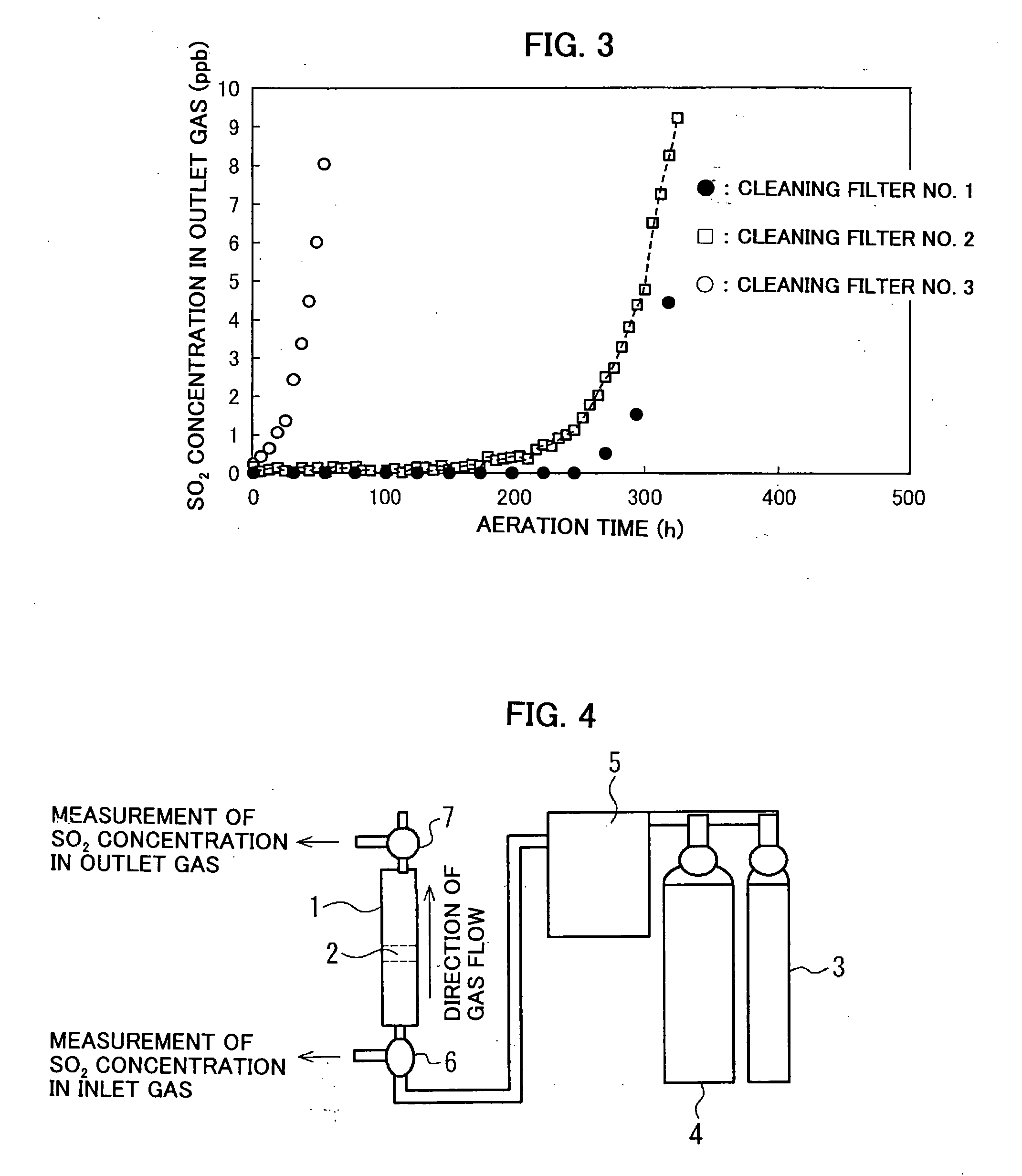Method and device for decontamination air for fuel cell, and fuel cell
a fuel cell and air technology, applied in the direction of electrochemical generators, dispersed particle separation, separation processes, etc., can solve the problems of reducing the generation efficiency and lifetime the condition for sufficiently preventing the decrease of the electromotive force of the fuel cell when the cleaning filter is actually used in the fuel cell system, and the cell voltage of the fuel cell decreases. , to achieve the effect of sufficiently preventing the decrease of the electromotive force of the fuel cell, stab
- Summary
- Abstract
- Description
- Claims
- Application Information
AI Technical Summary
Benefits of technology
Problems solved by technology
Method used
Image
Examples
experimental example 1
[0051] An experiment for investigating a relationship between a concentration of SO2 in air to be supplied to a cathode and a voltage decay rate was conducted by systematically changing the concentration of SO2 contained in the air used in a polymer electrolyte fuel cell (unit cell, effective area: 25 cm2). In each test differing SO2 concentrations, all fuel cells had the same specification and were in the unused state, and all conditions for the test were the same. A carbon-supported noble metal catalyst, which is generally used as an electrode catalyst of polymer electrolyte fuel cells, was used as an electrode catalyst; a platinum-ruthenium alloy catalyst was used as an anode catalyst; and a platinum catalyst was used as a cathode catalyst.
[0052] The anode and cathode of the unit cell of the polymer electrolyte fuel cell having the above-mentioned constitution were supplied with hydrogen humidified to 100% relative humidity and air humidified to 90% relative humidity, respective...
manufacturing example 1
[0056] Polyether-polyurethane foam having cells removed membranes thereof at 10 PPI (the foam: 250 mm×250 mm×5 mm (thickness), Tradename: Everlight SF, Product Number: QW-09 5t, manufactured by Bridgestone Corporation) was used as a filter base. This foam was impregnated with a polyether urethane emulsion binder containing 50 wt % of a solid component so that the amount of the adhered binder per unit volume of the filter base was 30 g / L as a dried resin. After the drying at 100° C. for 5 min, coconut-shell activated charcoal having an average particle size of 30 mesh (BET specific surface area: 1500 m2 / g) was uniformly supplied and adhered to both surfaces of and further into the base by dropping through a sieve. The amount of the activated charcoal was controlled to 150 g / L per unit volume of the filter base. Then, in order to improve the performance of the filter for removing a sulfur compound, a solution containing 13.8 wt % of potassium carbonate was applied to both surfaces of ...
experimental example 2
[0057] The cleaning filter materials prepared in Manufacturing example 1 each having a thickness of 5 mm were stacked at the number of sheets shown in Table 1 to obtain three types of cleaning filter Nos. 1, 2, and 3 having the total thicknesses shown in Table 1. By using these cleaning filters, the SO2 gas adsorption test and the pressure drop measurement below were carried out.
[SO2 Gas Adsorption Test]
[0058] An accelerating test at a SO2 concentration of 500 ppb, which is equivalent to about 100 times the SO2 concentration in atmospheric air, was conducted using a test device shown in FIG. 4.
[0059] The cleaning filter No. 2 was cut so as to have a diameter of 20 mmφ. The cut cleaning filter is disposed in a vertical column 1 (a glass column having an internal diameter of 20 mmφ and a length of 200 mm) shown in FIG. 4 at a substantially center portion in the height direction of the column so that the thickness direction of the filter is the height direction of the column. SO2 ga...
PUM
| Property | Measurement | Unit |
|---|---|---|
| length | aaaaa | aaaaa |
| area | aaaaa | aaaaa |
| current density | aaaaa | aaaaa |
Abstract
Description
Claims
Application Information
 Login to View More
Login to View More - R&D
- Intellectual Property
- Life Sciences
- Materials
- Tech Scout
- Unparalleled Data Quality
- Higher Quality Content
- 60% Fewer Hallucinations
Browse by: Latest US Patents, China's latest patents, Technical Efficacy Thesaurus, Application Domain, Technology Topic, Popular Technical Reports.
© 2025 PatSnap. All rights reserved.Legal|Privacy policy|Modern Slavery Act Transparency Statement|Sitemap|About US| Contact US: help@patsnap.com



